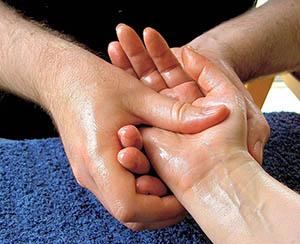 The National Center for Health Statistics reports that around 260,000 surgeries are performed each year for carpal tunnel. Carpal tunnel syndrome (CTS) occurs when the median nerve that runs through your arm and wrist into the hand is compressed in an area of the wrist called the carpal tunnel. It causes inflammation of the nerve and symptoms are felt as a gradual onset of burning, tingling (especially in the thumb and first two fingers), and the symptoms are usually worse at night. Pain may radiate as far up as the shoulder area. Commonly there will be a sensation of swelling in the fingers, and grip strength is decreased. CTS seems to be related to anatomy of the wrist, various health issues and repetitive jobs requiring use of the hand and fingers.
The National Center for Health Statistics reports that around 260,000 surgeries are performed each year for carpal tunnel. Carpal tunnel syndrome (CTS) occurs when the median nerve that runs through your arm and wrist into the hand is compressed in an area of the wrist called the carpal tunnel. It causes inflammation of the nerve and symptoms are felt as a gradual onset of burning, tingling (especially in the thumb and first two fingers), and the symptoms are usually worse at night. Pain may radiate as far up as the shoulder area. Commonly there will be a sensation of swelling in the fingers, and grip strength is decreased. CTS seems to be related to anatomy of the wrist, various health issues and repetitive jobs requiring use of the hand and fingers.
While carpal tunnel is a real issue, it is often misdiagnosed. Often what is labeled carpal tunnel is actually thoracic outlet syndrome or tendonitis of the forearm. Thoracic outlet syndrome causes much of the same symptoms as CTS. It it caused by nerve and blood vessel entrapment in the front of the neck and chest area. Tendonitis can also cause many of the same symptoms and is usually brought about by injury or repetitive movements of the forearm muscles that control the movement of the hand and fingers.
Only a doctor should diagnose your condition. However, before you commit to any surgery, bring up possible alternatives such as massage and/or physical therapy as effective options for treatment. A course of massage with at home use of NSAID’s, cold packs, splints and rest for the arm can usually improve any of the above issues within a few months if the massage and/or physical therapy are done correctly.
If you have a massage therapist with a sound knowledge of these conditions and the muscles and nerves involved, they can effectively treat the muscles of the forearm, chest area and neck area. Most often this will include the scalenes of the neck, the pectoralis muscles of the upper chest, the brachialis of the upper arm, and the various hand and finger extensor and flexor muscles located in the forearm. They will also show you how to work with the muscles yourself in between visits, how to stretch them and simple exercises to build up strength as your symptoms improve.
Again it is important to find a therapist skilled in treating specific neuromuscular conditions. Ask if they have had any specific training for your complaint or past success in treating clients. If you have been diagnosed with carpal tunnel syndrome and want to take a less invasive approach to treatment, contact us and get started with massage therapy.
Photo: Lubyanka [CC-BY-SA-3.0], via Wikimedia Commons
